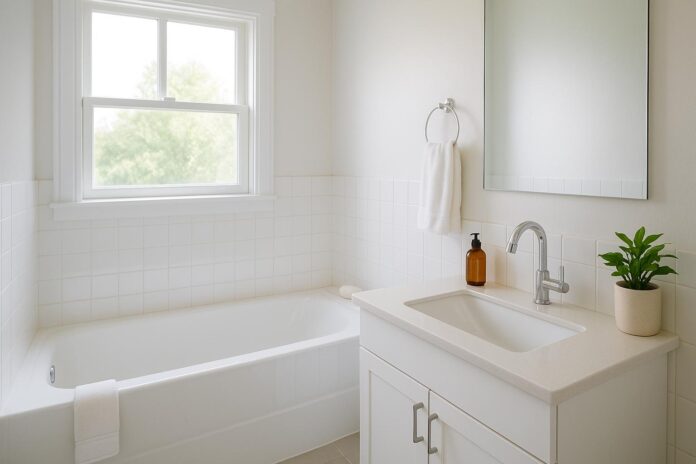Bathroom mold is one of the most common household problems. Humidity, steam, and poor ventilation create the perfect breeding ground for mold to thrive. Beyond its unsightly appearance, mold can also cause health problems, especially for people with allergies or asthma. In this article, you’ll find practical and easy-to-follow tips to prevent mold from returning, keeping your bathroom clean, healthy, and pleasant.
Why does mold appear in bathrooms?

Mold develops when moisture and poor air circulation meet. Wet tiles, grout, and walls that remain damp for long periods provide ideal spots for mold spores to grow. In addition, soap scum and shampoo residue often encourage fungal development. For this reason, effective bathroom humidity control is crucial.
Essential tips to prevent bathroom mold

1. Ensure proper ventilation
The most important rule in mold prevention is ventilation. Always open a window or leave the bathroom door ajar after taking a shower. If there’s no natural airflow, consider installing an exhaust fan to remove excess steam. Good airflow is the foundation of any mold-free bathroom solution.
2. Dry surfaces after use
After each shower:
- Use a squeegee to wipe mirrors and tiles.
- Quickly dry walls and corners with a clean towel.
This reduces surface moisture and minimizes mold growth. These simple bathroom cleaning tips make a huge difference over time.
3. Clean regularly
Mold thrives on soap and shampoo residues. Clean your bathroom frequently with a mild cleaner or natural solutions such as vinegar or baking soda. Regular cleaning is one of the easiest ways to prevent black mold in shower areas.
4. Dry towels and rugs
Never leave wet towels hanging inside the bathroom. Instead, dry them outdoors or wash them immediately. Apply the same rule to bath rugs, which often trap hidden moisture.
5. Inspect grout and sealant
Grout lines and silicone seals around bathtubs and sinks are the first places mold appears. If you notice cracks or discoloration, replace them promptly to prevent further growth. This step is an important part of home maintenance for bathrooms.
6. Use a Dehumidifier
In bathrooms without windows, a dehumidifier can work wonders. By lowering humidity levels, it creates an environment where mold struggles to survive.
7. Choose anti-mold products
Invest in mold-resistant paint and sealants for walls and ceilings. These products provide long-lasting protection and reduce the likelihood of recurring problems.
Natural remedies to prevent mold

If you prefer eco-friendly cleaning solutions, consider these effective options:
- Vinegar: Perfect for cleaning grout lines and killing spores.
- Baking Soda: Absorbs moisture and eliminates odors.
- Tea Tree Oil: A natural essential oil with antifungal properties.
Common mistakes to avoid
Many homeowners unknowingly make mold worse. Avoid these practices:
- Painting over mold without cleaning it first – it will reappear quickly.
- Leaving standing water on the bathroom floor.
- Storing too many items (baskets, bottles, soaps) that trap humidity and prevent airflow.
Conclusion
Bathroom mold is not only a cosmetic issue but also a health concern. With simple yet consistent habits like proper ventilation, surface drying, and regular cleaning, you can effectively prevent mold from coming back. By investing a little effort in prevention, you’ll enjoy a bathroom that stays clean, healthy, and mold-free for longer.



